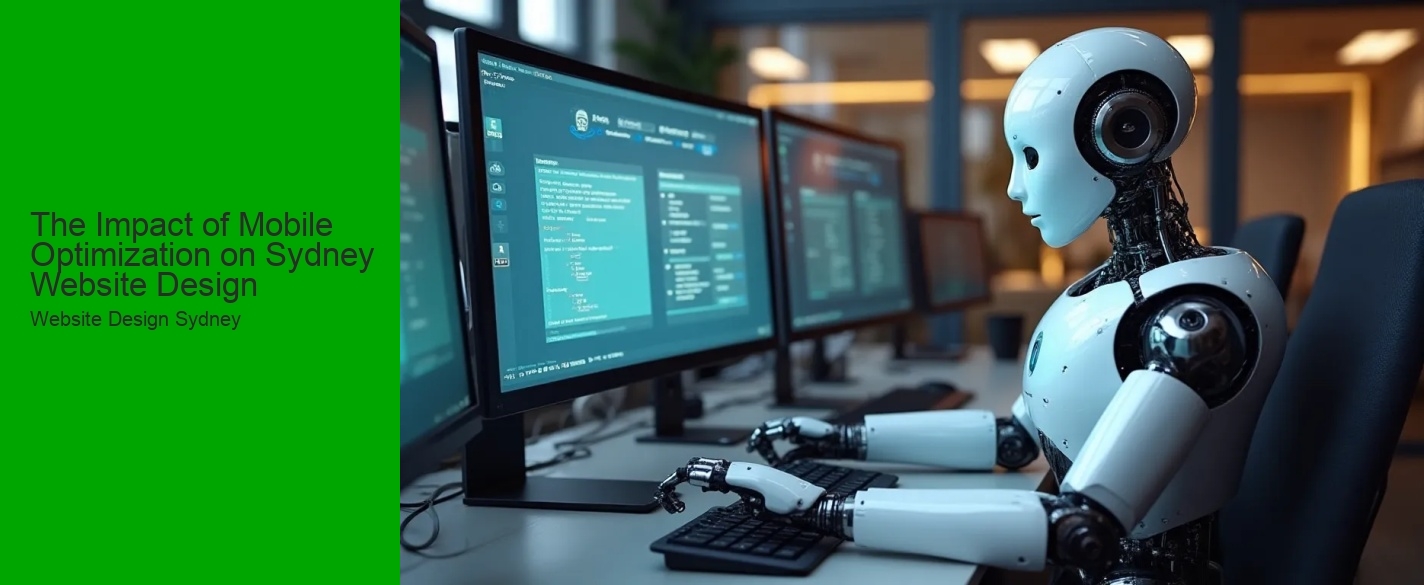Understanding Mobile Optimization and Its Importance
Understanding Mobile Optimization and Its Importance for topic The Impact of Mobile Optimization on Sydney Website Design
Right, so, mobile optimization! Best Sydney Website Design NSW. It aint just some fancy tech buzzword; its, like, super important, especially when youre talkin about Sydney web design. Think about it: everyones glued to their phones these days, right? (I mean, you probably are right now!) If your website doesnt look good and work well on a mobile device, well, youre basically invisable to a huge chunk of potential customers.
Its not rocket science, but it does require some thought. A site thats a pain to navigate on a phone--tiny buttons, slow loading times, text that's way too small?--people arent going to stick around. Nah, theyll bounce faster than a kangaroo on a trampoline. Which means lost business, lost leads, and a whole lotta frustration for everyone involved.
We need to consider the Sydney context too. People are busy, always on the go, checking their phones on the train, at the beach, even waiting for their coffee!
The Impact of Mobile Optimization on Sydney Website Design - Bespoke Landing Page Small Business Web Design For Sydney Joiners
- Fast Turnkey Website Design Sydney For Home Warranty Providers
- Interactive Small Business Web Design For Sydney Cabinetmakers
- Wordpress Website Design Sydney For Plumbing Businesses
Neglecting mobile isnt an option! It affects how search engines rank your site too, ya know? Google, for example, prioritizes mobile-friendly websites. So, if youre not optimized, you might as well be shoutin into the void. Its about creating a seamless and intuitive experience for users, regardless of the device theyre using. And that, my friends, is why mobile optimization is absolutely crucial for Sydney website design.
Mobile-First Indexing and Sydney SEO
Mobile-First Indexing is kinda a big deal nowadays, especially for businesses aiming to thrive in Sydneys competitive digital landscape. So, what does this mean for website design in the city? Well, it's all about prioritizing mobile optimization!
You see, Google has shifted its focus towards mobile versions of websites when determining rankings. This means that if a site isn't optimized for mobile users, it's not likely to perform well in search results. And let's be honest, nobody wants to be buried on the second page of Google, right? Sydney locals are increasingly using their smartphones to search for services, whether it's a cozy café in Surry Hills or the latest fashion trends in the CBD. If a website isnt mobile-friendly, potential customers may just bounce off to competitors who have better mobile experiences.
Now, when designing for mobile, it's crucial to consider how a site looks and functions on smaller screens. This doesn't just mean shrinking everything down; it's about rethinking the layout! You might not want to overcrowd a mobile page with too much text or images. Instead, simple navigation and fast loading times are key. Plus, let's not forget about touch-friendly buttons – no one likes fumbling around trying to click a tiny link!

In Sydney, where the population is diverse and tech-savvy, having a responsive design can be the difference between attracting new clients and losing them to others. Businesses that ignore mobile optimization are, quite frankly, missing out on a huge chunk of potential traffic. It's not just about looking good on mobile; it's about functionality and user experience.
In conclusion, embracing Mobile-First Indexing isn't just a trend, it's a necessity for website design in Sydney. Those who adapt will find themselves ahead of the game, while those who don't may struggle to keep up. Custom Form Builder Website Design Sydney For Fencing Supply Shops So, let's not delay – optimizing for mobile is the way to go!
Key Elements of Mobile-Optimized Website Design for Sydney Businesses
When it comes to Key Elements of Mobile-Optimized Website Design for Sydney businesses, things can get pretty complicated! I mean, we dont wanna end up with a site that looks all messy on smartphones or tablets, right? So, lets break it down a bit.
First up, you gotta have a responsive design. That means your website should be able to adjust its layout automatically based on the device its being viewed on. Without this, your customers might just bounce off if they find your site cramped or hard to navigate on their phones!
Another crucial element is speed. No one likes waiting around for pages to load, especially when theyre using mobile data which can be slower than wi-fi. A site that takes forever to load could drive your visitors away faster than you can say "responsive design"!
User-friendly navigation is also a big deal. Make sure your menu options are easy to find and tap on those small screens. If it feels like a maze, people wont stick around long enough to figure it out.
Lastly, dont forget about content. It needs to be concise and scannable, with clear headings and bullet points. People usually check their phones quickly, so you need to get your message across without them having to scroll for ages.

And speaking of scrolling, avoid using too many pop-ups or auto-playing videos. They can be really annoying and might even make people leave your site altogether!
So yeah, while theres no denying that mobile optimization adds another layer of complexity to web design, its definitely worth it if you want to keep your Sydney business relevant in todays digital world. Neglecting these key elements could mean missing out on a whole bunch of potential customers who prefer browsing on their mobile devices.
User Experience (UX) and Mobile Optimization: A Sydney Focus
User Experience (UX) and Mobile Optimization: A Sydney Focus
In today's fast-paced digital world, having a website that's not just visually appealing but also functional is super important! In Sydney, where the tech scene is buzzing, businesses are realizing that mobile optimization is key to enhancing user experience (UX). You can't ignore the fact that a significant number of users access websites from their mobile devices. If a site isn't optimized for mobile, it can lead to frustration and, ultimately, loss of potential customers.
When we talk about mobile optimization, we mean ensuring that a website is responsive and user-friendly on smaller screens. Many Sydney-based companies have made the mistake of thinking that a desktop version is enough, but that's simply not true. Most people aren't sitting at their desks all day anymore; they're out and about, using their phones to browse, shop, or find services. So, having a site that works well on mobile is not just a nice-to-have; it's a must!
Moreover, Google's algorithms favor mobile-friendly websites in search rankings. This means that if your site isn't optimized, it could be buried deep in search results, making it hard for users to find you. In a competitive market like Sydney, you really don't want to be missing out on traffic and potential sales because your website isn't mobile-optimized.
Now, let's not forget about the design aspect. A great UX isn't just about how a site looks; it's about how easy it is to navigate. Sydney designers are increasingly focusing on creating intuitive interfaces that guide users seamlessly through their sites. They're using larger buttons, simplified menus, and clear calls to action, all tailored for mobile users. This kind of thoughtful design can really make a difference in keeping visitors engaged.

In conclusion, the impact of mobile optimization on website design in Sydney is undeniable. It's not just about looking good; it's about providing a seamless experience for users on the go. Failing to prioritize mobile-friendly design can seriously hinder a business's success in this vibrant city. So, if you haven't jumped on the mobile optimization bandwagon yet, it's high time you do!
Mobile Optimization Tools and Techniques for Sydney Web Designers
The Impact of Mobile Optimization on Sydney Website Design
Sydney web designers, theyve got a tough gig, havent they? In this day and age, you cant not think mobile-first. The impact of mobile optimization, well, its not just a little tweak anymore; its fundamentally reshaping how websites are conceived and built in the Harbour City.
Mobile Optimization Tools and Techniques, huh? Think responsive design – its no longer optional; its a necessity. (And if you arent using it, what are you thinking?) But its more than just making things fit on smaller screens. Its about considering the entire user experience. Modern Website Design Sydney For Home Extension Builders Are your images optimized for faster loading times? Nobody, and I mean nobody, wants to wait for a webpage to load on their phone, especially when theyre out and about, you know.
Techniques like lazy loading (oh, the joy!) and minifying code are all crucial. We cant overlook the importance of touch-friendly navigation, either. Tiny buttons? Forget about it! And accessibility, gosh, its paramount. We shouldnt exclude anyone from having a good experience.
Furthermore, local SEO is, like, super important for businesses in Sydney. Mobile users are often looking for things nearby, so ensuring a website is optimized for local search is key. Claiming that Google My Business listing? Absolutely crucial. Ignoring that would be a mistake!
Its a challenge, sure, but Sydney web designers are adapting. Theyre embracing these tools and techniques, creating websites that are not only beautiful but also functional and accessible on any device. And thats good, innit?!
Case Studies: Successful Mobile-Optimized Websites in Sydney
Case studies on successful mobile-optimized websites in Sydney really highlight the impact of mobile optimization on website design! Take for example, a local café that revamped their site to be mobile-friendly. Beforehand, their design was cluttered, and their navigation was a nightmare on smaller screens. But now, with a sleek, user-friendly mobile layout, theyve seen a huge boost in online orders. Its amazing how a simple redesign can make such a difference!
Another standout is a fashion retailer who initially ignored mobile optimization. Their sales were slipping, and customer feedback was less than enthusiastic. They realized they were alienating a significant portion of their audience who preferred shopping on their smartphones. A redesign later, and their site is now not only mobile-friendly but also visually stunning. The result? A surge in sales and happier customers.
Now, you might think a big tech company with a massive budget wouldnt need to worry about mobile optimization. But even they got it wrong initially. Their complex design was a headache on mobile devices, leading to high bounce rates and frustrated users. After investing in a more mobile-oriented approach, their site performance improved dramatically. It just goes to show that no one is immune to the need for mobile optimization.
On the flip side, there are businesses that didnt make the switch and are now struggling to keep up. Their websites are outdated, and their designs are a relic of the past. Neglecting mobile optimization means missing out on a huge chunk of potential customers.
The Impact of Mobile Optimization on Sydney Website Design - Affordable Landing Page Design Sydney For Emergency Plumbing Services
- Affordable Website Design Sydney For Home Renovation Businesses
- Dynamic Small Business Web Design For Sydney Earthmoving Contractors
- Budget Small Business Web Design For Sydney Landscapers
- Subscription Website Design Sydney For Maintenance Service Providers
In conclusion, the impact of mobile optimization on Sydney website design cant be overstated. Its not just about making a website look good on a smaller screen; its about providing a seamless user experience that can make or break a business. So, whether youre a small café or a big tech company, ignoring mobile optimization is not an option!
Future Trends in Mobile Optimization for Sydney Website Design
Hey there! So, talking bout future trends in mobile optimization for Sydney website design? Its a whole new ballgame! You know, with more and more people browsing the web on their phones, its crucial to keep up. One things for sure, designers cant afford to ignore how mobile optimization impacts their work.
First off, lets not forget about speed. Who wants to wait around for a page to load? Nobody! And guess what? Users in Sydney are no different. They expect quick load times, no matter where they are or what device theyre using. Its all about that instant gratification.
But, heres the kicker – its not just about speed. Its also about usability. A website that looks great on a desktop might not cut it on a tiny screen. Think about it, trying to navigate a cluttered layout with a tiny touchscreen isnt exactly a walk in the park. So, designers gotta think outside the box and create an experience thats intuitive and easy to use, no matter the device.
Now, dont get me wrong, responsive design is awesome. It allows a website to adapt to different screen sizes, which is super handy. But its not the end-all-be-all. Theres a growing trend towards something called "mobile-first" design. This means starting with the mobile experience in mind and then building up to desktop. Its all about prioritizing the needs of mobile users first.
Speaking of which, content is king, right? Well, in the mobile age, its more like king of the hill! With limited screen real estate, every word counts. Short, punchy content is the way to go. Its about getting to the point quickly and effectively. And, lets face it, nobody wants to scroll through pages and pages of text on their phone. Its just not happening!
Alright, so what does all this mean for Sydney website designers? Well, for starters, they need to stay on top of the latest trends and technologies. And they cant afford to overlook the importance of mobile optimization. Neglecting it could be a huge mistake. Users expect a seamless experience, and if they dont get it, theyll take their business elsewhere. So, designers gotta put on their thinking caps and figure out how to create websites that not only look great but also work well on mobile devices.
In the end, its all about meeting the needs of the users. And with the increasing reliance on mobile devices in Sydney, that means mobile optimization is more important than ever. So, heres to the future of mobile optimization and the impact its having on website design in Sydney!



